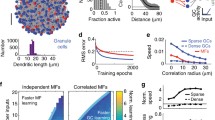Abstract
It has been claimed that pattern separation in cerebellar cortex plays an important role in controlling movements and balance for vertebrates. A number of the neural models for cerebellar cortex have been proposed and their pattern separability has been analyzed. These results, however, only explain a part of pattern separability in random neural nets. The present paper is intended to study an extended theory of pattern separability in a new model with inhibitory connections. In addition to this, the effect of the number of connections on pattern separability is cleared up. It is also shown that the signal from the inhibitory connections has crucial importance for pattern separability.
Similar content being viewed by others
References
Marr, D.: A theory of cerebellar cortex. J. Physiol. 298, 437–470 (1969)
Eccles, J.C., Ito, M., Szentágothai, J.: The cerebellum as a neuronal machine. Berlin, Heidelberg, New York: Springer 1967
Eccles, J.C.: The cerebellum as a computer: patterns in space and time. J. Physiol. 229, 1–32 (1973)
Mittenthal, J.E.: Reliability of pattern separation by the cerebellar mossy fiber-granule cell system. Kybernetik 16, 93–101 (1974)
Albus, J.S.: Theory of cerebellar function. Math. Biosci. 10, 25–61 (1971)
Albus, J.S.: A new approach to manipulator control: the cerebellar model articulation controller (CMAC)1. Trans. ASME 200–227 (1975)
Albus, J.S.: Data storage in the cerebellar model articulation controller (CMAC)1. Trans. ASME 228–233 (1975)
Pelionisz, A.: Computer simulation of the pattern transfer of large cerebellar neuronal fields. Acta Biochem. Biophys. Acad. Sci. Hung. 5, 77–79 (1970)
Pelionisz, A., Szentágothai, J.: Dynamic single unit simulation of a realistic cerebellar network model. Brain Res. 49, 83–99 (1973)
Sabah, N.H.: Reliability of computation in the cerebellum. Biophys. J. 11, 429–445 (1971)
Nagano, T.: Some consideration on learning algorthm. Trans. Inst. Electron. Commun. Eng. Jap., 57-D, 661–667 (1974)
Torioka, T., Koga, K.: Analysis of layered neuron network. PGMBE, Inst. Electron, Commun. Eng. Jap., Paper MBE-76-24, 89–96 (1976)
Torioka, T., Ikeda, N., Nawata, K.: Effects of the number of connections on pattern separability of random nerve net with inhibitory connections. PGMBE, Inst. Electron. Commun. Eng. Jap. MBE-77-21, 29–39 (1977)
Torioka, T., Koga, K.: Effect of stochastic parameters on a separation function of pattern. Inst. Electron. Commun. Eng. Jap. 60-A, 213–215 (1977)
Torioka, T.: Characteristics of two layered random network. Trans. Inst. Electron. Commun. Eng. Jap. 59-A, 170–171 (1976)
Torioka, T., Koga, K.: Pattern separability of a three-layer random nerve net with inhinitory connections. Electro. Commun. Eng. Jap., 60-A, 1153–1159 (1977)
Kosugi, Y., Naito, Y.: Considerations on pattern separation in randomly-connected layered neural networks. Trans. Inst. Electron. Commun. Eng. Jap. 58-D, 539–547 (1975)
Author information
Authors and Affiliations
Additional information
1977–1978 Exchange Visitor, on leave from the Department of Information Processing Engineering, Technical College, Yamaguchi University, Yamaguchi University
Rights and permissions
About this article
Cite this article
Torioka, T. Pattern separability and the effect of the number of connections in a random neural net with inhibitory connections. Biol. Cybernetics 31, 27–35 (1978). https://doi.org/10.1007/BF00337368
Received:
Issue Date:
DOI: https://doi.org/10.1007/BF00337368




